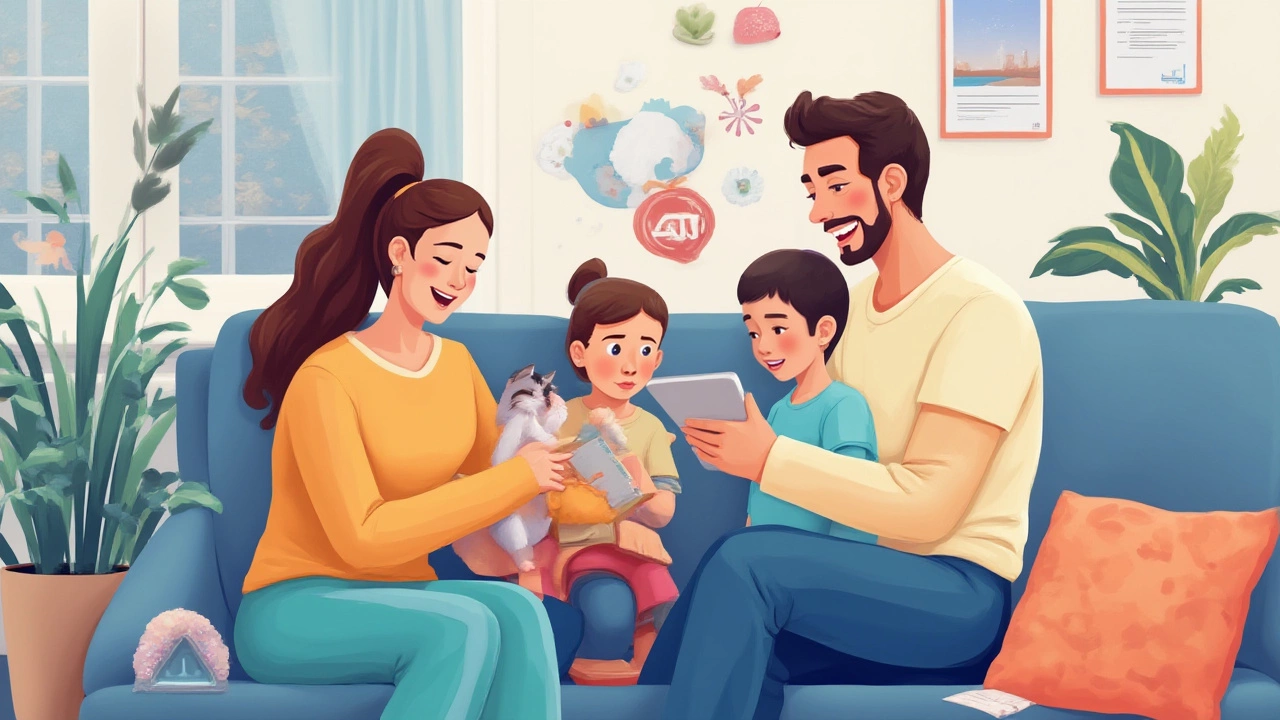 Jul, 27 2025
Jul, 27 2025
If you’ve ever found yourself Googling symptoms in the early hours, you’re not alone. But what happens when self-diagnosis just won’t cut it and the nearest GP can’t see you until next week? The rise of online doctors—virtual GPs—has flipped the script for Kiwis needing real medical help without the waiting room magazines. But can these digital docs actually write valid prescriptions, and is it as reliable as popping down to the local clinic with your paper script in hand?
How Virtual Prescriptions Work: The Digital Clinic Experience
The way we access healthcare is evolving at a breakneck pace. Instead of battling traffic and queuing for hours, you can meet a doctor face-to-face—through your laptop or phone screen. In New Zealand, legitimate platforms such as CareHQ, Tend, Better Health, and Practice Plus have all popped up, offering real-time video appointments with registered, qualified doctors. It’s not just a chatbot doing guesswork; you’re seeing people who are licensed by the Medical Council of New Zealand. This matters, because only registered practitioners have the right to write medical prescriptions.
To get a digital prescription, you usually book an appointment online, fill out basic details, upload your ID, and set your preferred time slot. During the consult, the online doctor will clarify symptoms, your medical history, allergies, and any medications you’re currently taking. If a prescription is needed, most systems email it directly to your chosen pharmacy or send it via a secure digital channel, ready for pickup, or—in some cases—even arrange home delivery. Many patients love this setup for its privacy, speed, and the ability to get help when the regular clinics are closed, like late nights or public holidays.
But not every medication is available by this route. New Zealand law and Medical Council protocols specify that online doctors can only prescribe if they feel confident they have enough information to make a safe call. If a physical examination is needed or if there are red flags in your symptoms, they’ll refer you to a bricks-and-mortar clinic. Expect this especially for controlled substances (like strong painkillers or psychiatric meds) and medicines that can be misused or require careful monitoring.
Kids under two years old, conditions needing visual checks (say, an odd-looking skin rash), or signs of something urgent (chest pain, severe shortness of breath) are almost always redirected to in-person care. It’s not about stinginess—it’s about safety. If you’re after a repeat prescription for a medication you’ve been on for a while, online consultations can be a breeze. For new medications or complicated cases, more questions or even lab tests might be required.
Legal Rules, Safety Nets, and Doctor Accountability
There’s no wild west here. In New Zealand, the Medical Council has strict guidelines. All online doctors must hold current practicing certificates and follow medical best practice—exactly as they would if you were sitting in their actual office. Every prescription, virtual or paper, must be backed with proper notes. Consultation records are kept (often with patient access online), so there’s traceability if a pharmacy or another doctor needs to check what you’ve been prescribed.
For prescription security, electronic scripts are created using encrypted signatures to prevent tampering. These e-prescriptions get sent directly to pharmacies using the country’s NZePS (New Zealand Electronic Prescription Service) network. This helps pharmacists confirm authenticity instantly. Pharmacies are trained to spot and flag anything dodgy. If someone tries to game the system with fake profiles or doctor-shopping, it’s far harder than it used to be—fraud detection software and ID checks make things pretty secure.
A lot of Kiwis don’t realize telehealth platforms are legally required to protect your privacy to the same level as a hospital. All your health data is encrypted, with nobody accessing it except you and your medical team. And if you ever need a record of what was said or prescribed, most platforms can send you a full summary after each appointment.
But what if a prescription goes wrong, or a doctor issues something inappropriate? They’re just as accountable as in-person GPs. You have the right to complain to the Health and Disability Commissioner, and all medical practitioners answer to the same legal bodies. Insurance and indemnity for telehealth work just like regular GP cover, so there’s real accountability here.

What Online Doctors Can and Can’t Prescribe: A Closer Look
Let’s get specific—most everyday prescriptions for infections (like antibiotics for a sore throat), minor skin conditions (eczema creams), or the contraceptive pill can be handled online if the consultation checks out. Asthma inhalers, antihistamines, and some blood pressure medicines are also common repeat prescriptions that virtual clinics handle routinely.
But controlled drugs—think opiates (painkillers like oxycodone, morphine), benzodiazepines, or strong sleep medications—are rarely prescribed through telehealth platforms. The Ministry of Health bars these from online prescribing both for legal and safety reasons. Even medications for ADHD or certain antidepressants fall into a grey zone: a virtual doctor might provide repeats if you’ve had a stable long-term relationship with their clinic, but they can’t start new patients on these without closer in-person checks.
Some specialist-only meds (like chemotherapy) are always out of bounds for online clinics. And if you need blood tests, imaging, or any procedure, you’ll get a referral to a traditional clinic. A physical exam still has an irreplaceable role—no webcam yet replaces a stethoscope or a hands-on check for lumps, rashes, or odd symptoms.
However, many everyday health issues can be safely managed via video. In fact, recent research from Otago Medical School shows repeat prescription requests and minor ailment management can be delivered online with high satisfaction rates and comparable outcomes to face-to-face care. Some pharmacies now even offer video consults as part of their service, bridging the gap for rural Kiwis with long drives to the nearest doctor.
Benefits of Digital Prescriptions: Saving Time, Money, and Stress
The big win? Convenience. No battling for car parks or swapping bugs with snifflers in a busy waiting area. Online doctor consults mean you can see a GP from your couch—often with same-day appointments and less hassle. This matters a lot for parents of busy kids, shift workers who can’t take a morning off, or anyone living outside the big cities. Telehealth bridges a lot of gaps for rural communities in particular.
Time isn’t the only thing you save. Many virtual GPs charge lower fees than traditional clinics—sometimes $20–$50 less per consult, depending on the service and your region. There’s no need to print or courier physical scripts, and most pharmacies now prefer e-prescriptions for their traceability. Plus, e-scripts cut down mistakes from messy handwriting or lost documents.
Another huge benefit lies in privacy. If you want to discuss sensitive issues (sexual health, mental wellbeing, or embarrassing skin conditions), it can feel easier to open up at home rather than in a crowded surgery. ADHD, anxiety, contraception, acne—these are common, real-world examples where Kiwis say the digital route is more comfortable.
The quick turnaround matters in emergencies too. Imagine you’re on holiday in Queenstown and run out of your medication. Instead of waiting hours in a walk-in clinic, you can often have a script sent to the nearest pharmacy within minutes. Some telehealth providers partner up with pharmacies to arrange after-hours pickup, or even deliver to your door. Just remember, in true emergencies—chest pain, severe infection, sudden breathing problems—call 111 or head straight to an A&E. Telehealth is for wounds, not emergencies.

Tips for Using Online Prescriptions Safely and Smartly
Getting the most out of your virtual doctor starts with good preparation. Set up in a quiet, private space with stable Wi-Fi, and have a list of symptoms, questions, and any meds you’re taking. Upload recent blood test results, if relevant. Having your ID ready speeds up things, as does knowing the details of your local pharmacy so the script lands in the right inbox.
Be savvy with telehealth providers. Only use New Zealand–based services with registered NZ doctors—this ensures they stick to local guidelines and have the authority to prescribe within Aotearoa. Overseas clinics can’t legally issue NZ prescriptions, and some sketchy websites may offer “miracle” pills without any medical consultation—big red flag. Trusted services display their practitioners and Medical Council numbers prominently.
For ongoing prescriptions, remember most online clinics are happy to work with your regular GP, sharing records if you allow it. This keeps your health history up-to-date, which is critical for long-term conditions. Some medications—like blood thinners or insulin—need monitoring, so you might still need a face-to-face check-in every year or two for safety’s sake.
- If your symptoms change, worsen, or something feels off, always follow up with a real-life appointment.
- Double-check the pharmacy before picking up new meds—if an e-script doesn’t appear in their system, call your virtual clinic. Mistakes are rare, but sorting them is much faster if you act early.
- For repeat scripts, book a few days ahead of running out—busy periods or tech hiccups happen. Most telehealth clinics offer reminders by email or app notification.
- Stay alert to fake pharmacies online—these might ask for payment upfront without seeing a real doctor and can be risky or illegal.
- Online doctors can feel just as personal and reassuring as in-person care, especially once you find a clinic you trust. Stick with platforms that encourage safe, two-way communication.
The bottom line: Yes, online doctors in New Zealand can write real prescriptions, and for everyday health needs or repeat scripts, it’s fast, safe, and legit. Just keep using them wisely and know when it’s time to leave the screen behind and see someone in real life.
